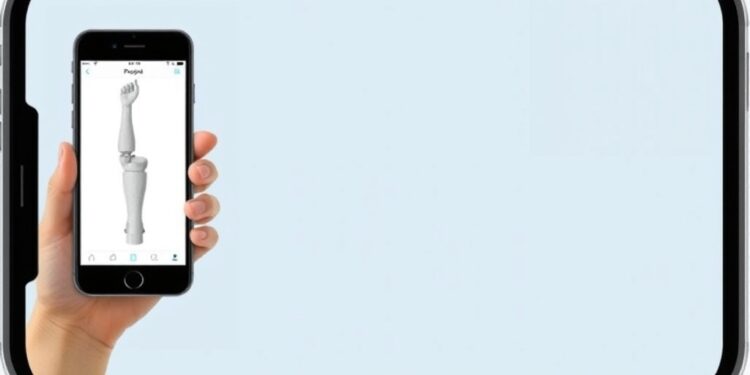The field of wearable robotics is on the brink of significant innovation with the introduction of an adaptive prosthetic liner known as ‘Roliner’. This groundbreaking technology is developed to address a long-standing challenge faced by amputees: achieving a comfortable and responsive fit for prosthetic limbs. Traditional prosthetics use rigid materials that can lead to discomfort and inefficiency because they fail to adapt to the changes in a person’s body over time. By utilizing a proprietary material, Roliner gives amputees an unprecedented level of customization directly from their smartphones, offering adjustments to shape, volume, and stiffness in real-time.
The creators of Roliner, researchers at the Imperial College London’s Department of Bioengineering, have spent eight years meticulously refining this technology through extensive prototype development and clinical trials. Their efforts culminated in the publication of their research in the prestigious journal Nature Communications, marking a significant milestone for both science and prosthetic design. This patent-pending material not only presents a solution to the persistent issues surrounding prosthetic fittings but also demonstrates the remarkable effort put forth by the research community to improve quality of life for amputees.
At the heart of this innovation lies the ability of Roliner to change its properties dynamically. It is composed of silicone elastomers designed with internal channels that can be pressurized. This allows the liner to inflate and deflate similarly to a basketball, adapting its physical characteristics in alignment with the user’s changing anatomy throughout the day. This addresses one of the primary grievances of amputees — the discomfort arising from a fixed, rigid shape that does not account for everyday variations like weight changes or fluctuations caused by hormonal cycles.
The principal investigator, Dr. Firat Guder, expressed the importance of this advancement in technology. In his observations, he emphasized the struggle of amputees with traditionally designed prosthetic limbs that fail to provide the close, comfortable connection necessary for daily activities. His team took an innovative approach by focusing on the interface between the body and prosthetic socket, rather than solely improving the prosthetic devices themselves. This perspective shift is expected to enhance the overall functionality and user experience of prosthetic limbs.
Another significant voice in this innovation is Dr. Uğur Tanriverdi, an Imperial College graduate, and the co-founder of Unhindr, the company responsible for bringing Roliner to market. He highlighted that poorly fitting prosthetic devices can cause multiple issues, from blisters and sores to deep-seated psychological effects. These complications can lead to extreme physical pain, reducing mobility to the point where individuals may have to rely on wheelchairs for daily activities. The implications of having a well-fitted prosthetic device extend beyond physical comfort; they can bolster a user’s confidence and overall mental health, enabling a more independent lifestyle.
The incorporation of artificial intelligence into Roliner stands out as a remarkable feature. This smart technology allows the liner to learn the preferences of the user over time, adjusting its properties automatically in response to daily changes. Whether it’s a matter of preferring a looser fit while seated or a firmer fit during walking, this adaptability ensures that amputees can enjoy a prosthetic experience that mirrors their specific needs. The promise of Roliner is not merely in its design, but in how it personalizes the experience of wearability for each individual user.
The technical construction of Roliner involves a complex interplay of mechanics and design that ensures functionality while maintaining comfort. By integrating a mechanism that allows for pressure modulation, the liner can respond to the slightest changes, offering a unique solution that blends traditional engineering with modern technology. Guglielmo Senesi, who is instrumental in developing the electronics and data architecture for Roliner, pointed out that this data-centric method marks a departure from the outdated, time-consuming plaster casting utilized in traditional prosthetic fitting. This innovation heralds a new age of prosthetic customization and efficiency.
Moreover, Tarek Asfour, who serves as the Chief Operating Officer of Unhindr, echoed these sentiments regarding the cultural shift in the prosthetic landscape. He underscored the transformation from inflexible mechanics to soft, adaptive robotics. The future of prosthetics, according to Asfour, is characterized not just by the ability to mimic movement but by establishing a seamless integration with the human body, enhancing not just functionality but also the quality of life for users.
The potential applications for Roliner extend well beyond prosthetic limbs. The researchers believe that the adaptive qualities of this technology could be harnessed in a variety of contexts. For instance, enhancing exoskeletons used in rehabilitation programs could make these devices more responsive and easier to wear, thereby improving recovery outcomes for patients. Furthermore, Roliner could modulate pressure points in hospital beds to increase comfort for patients, possibly reducing bedsores and improving recovery times. Even in high-stakes environments such as space travel, this adaptive material could provide better-fitting gear for astronauts, enhancing safety and performance in extreme conditions.
In summary, Roliner represents a significant breakthrough in the field of biomechanics, moving us closer to a future where prosthetics are personalized and functional in ways previously thought impossible. By tackling the core issues faced by amputees, it not only provides a solution for a long-standing problem but also reaffirms the incredible potential of interdisciplinary collaboration in addressing humanity’s challenges. This advancement serves as a beacon of hope for millions around the globe, ushering in a new era where technology and humanity converge for improved living standards.
This innovation is poised to redefine how prosthetic limbs are integrated into everyday life, reshaping perceptions and expectations of comfort and usability. As the research team continues to refine their work, attention now turns to how Roliner will be received by the amputee community and what further applications may arise as we begin to understand the true capabilities of this remarkable adaptive technology.
Subject of Research: People
Article Title: “Dynamically adaptive soft metamaterial for wearable human–machine interfaces”
News Publication Date: 19-Mar-2025
Web References: DOI
References: Nature Communications
Image Credits: N/A




